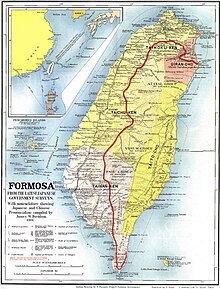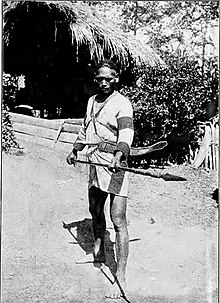Atayal people
Tayal, Tayan | |
|---|---|
 | |
| Total population | |
| 94,425 (2022,Nov) | |
| Regions with significant populations | |
| Taiwan | |
| Languages | |
| Atayal,Mandarin,Taiwanese,Yilan Creole Japanese | |
| Religion | |
| Animism,Christianity | |
| Related ethnic groups | |
| Seediq,Truku,Kavalan,Taiwanese Aborigines |
TheAtayal(Chinese:Thái nhã;pinyin:Tàiyǎ), also known as theTayaland theTayan,[1]are aTaiwanese indigenous people.The Atayal people number around 90,000, approximately 15.9% of Taiwan's total indigenous population, making them the third-largest indigenous group.[2][3]The preferredendonymis "Tayal"[citation needed],although the Taiwanese government officially recognizes them as "Atayal".[4]
Etymology
[edit]TheAtayalword for Atayal istayal,meaning "human" or "man".[5] The word the people use to refer to themselves is Tayal, almost never Atayal.
Origins
[edit]

The first record of Atayal inhabitance is found near the upper reaches of theZhuoshui River.During the late 17th century, they crossed the Central Mountain Ranges into the wilderness of the east. They then settled in theLiwu Rivervalley. Seventy-nine Atayal villages can be found here.[citation needed]
Genetics
[edit]Taiwan has been home to a number ofAustronesian indigenous groupssince before 4,000 BC.[6]However, genetic analysis suggests that the different peoples may have different ancestral source populations originating in mainland Asia, and developed in isolation from each other. The Atayal people are believed to have migrated to Taiwan from Southern China or Southeast Asia.[7]Genetic studies have also found similarities between the Atayal and other people in the Philippines and Thailand, and to a lesser extent with south China and Vietnam.[8]The Atayal are genetically distinct from theAmis people,who are the largest indigenous group in Taiwan, as well as from the Han people, suggesting little mingling between these people.[9]Studies on Mitochondrial DNA (mtDNA) polymorphisms suggest ancient migrations of two lineages of the various peoples into Taiwan approximately 11,000–26,000 years ago.[10]
Recent DNA studies show that theLapitapeople and modernPolynesianshave a common ancestry with the Atayal and theKankanaey peopleof the northernPhilippines.[11]
The Atayal are visibly different from the Han Chinese of Taiwan.[12]
Folklore
[edit]According to stories told by their elders, the first Atayal ancestors appeared when a stone, Pinspkan, cracked apart. There were three people, but one decided to go back into the stone. One man and one woman who lived together for a very long time and loved each other very much. But the boy was shy and wouldn't dare approach her. Whereupon, the girl came up with an idea. She left her home and found some coal with which to blacken her face so she could pose as a different girl.
After several days, she crept back into their home and the boy mistook her for another girl and they lived happily together. Not long after, the couple bore children, fulfilling their mission of procreating the next generation. The Atayal custom of face tattooing may have come from the girl blackening her face in the story.
Culture
[edit]Lifestyle
[edit]
The Atayal people have a distinct culture. They traditionally lived by fishing, hunting, gathering, and growingcropson burned-off mountain fields. The Atayal also traditionally practice crafts such as weaving, net knotting, and woodworking. They also have culturally specific musical instruments and dances.
The Atayal were known as skilled warriors. In a practice illegal since the Japanese Colonial Era (1895–1945), for a man to earn his facialtattoo,he had to bring back at least one human head; these heads, or skulls, were highly honored, given food and drink, and expected to bring good harvests to the fields. (SeeHeadhunting.) The Atayal are also known for the case of theWushe Incident,in which the Atayal participated in an uprising against colonialJapaneseforces.
The Lalaw Behuw, a type of long knife, was a weapon used by the Atayals.[13][14][15]
Traditional dress
[edit]
The Atayal are proficientweavers,incorporating symbolic patterns and designs on their traditional dress. The features are mainly ofgeometricstyle, and the colors are bright and dazzling. Most of the designs areargylesandhorizontallines. In Atayal culture, the horizontal lines represent the rainbow bridge which leads the dead to where the ancestors' spirits live. Argyles, on the other hand, represent ancestors' eyes protecting the Atayal. Thefavorite colorof this culture is red because it represents blood and power.
Facial tattoos
[edit]
The Atayal people are also known for using facial tattooing and teeth filing in coming-of-age initiation rituals. The facialtattoo,in Squliq Tayal, is calledptasan.In the past both men and women had to show that they had performed a major task associated with adulthood before their faces could be tattooed. For a man, he had to take the head of an enemy, showing his valor as a hunter to protect and provide for his people, while women had to be able to weave cloth. A girl would learn to weave when she was about ten or twelve, and she had to master the skill in order to earn her tattoo. Only those with tattoos could marry, and, after death, only those with tattoos could cross thehongu utux,or spirit bridge (the rainbow) to the hereafter.
Male tattooing is relatively simple, with only two bands down the forehead and chin. Once a male came of age he would have his forehead tattooed; after fathering a child, his bottom chin was tattooed. For the female, tattooing was done on the cheek, typically from the ears across both cheeks to the lips forming a V shape. While tattooing on a man is relatively quick, on a female it may take up to ten hours.[7]
Tattooing was performed only by female tattooists. The tattooing was performed using a group of needles lashed to a stick calledatoktapped into the skin using a hammer calledtotsin.Black ash would then be rubbed into the skin to create the tattoo. Healing could take up to a month.[7]
The Japanese banned the practice of tattooing in 1930 because of its association with headhunting. With the introduction of Christianity, the practice declined, and tattoos were only seen on the elderly. However, some young people in recent years have attempted to revive the practice.[7]By 2018 only one tattooed elder survived, Lawa Piheg, who was tattooed when she was 8.[16]Lawa Piheg died on 14 September 2019.[17][18]
Atayal in modern times
[edit]
The Atayal people in Taiwan live in central and northern Taiwan. The northernmost village is inUlay District(Wulai in Chinese), about 25 kilometers south of Taipei.The Atayal TribeThe community ofSmangusinJianshi Townshiphad become well known as a tourist destination, and an experiment incommunalism.[19]
Many Atayal are bilingual, but theAtayal languagestill remains in active use.
Notable Atayal people
[edit]- Esther Huang,actress and singer
- Jane Huang,singer of rock duoY2J
- Joanne Tseng,actress and member of pop duoSweety
- Kao Chin Su-mei,actress, singer and politician
- Laha Mebow,director, screenwriter, TV producer
- Landy Wen,singer
- Lo Chih-an,football player
- Lo Chih-en,football player
- Payen Talu,member ofLegislative Yuan(1996–2002)
- Vic Chou,actor and member of pop groupF4
- Vivian Hsu,actress
- Walis Nokan,writer.
- Yuming Lai,singer of rock duoY2J
- Yeh Shuhua,singer of K-pop group(G)I-DLE- Half Tayal on maternal side
- Jerry Yan,actor and member of pop groupF4
See also
[edit]References
[edit]- ^"Atayal".Digital Museum of Taiwan Indigenous Peoples.Archived fromthe originalon 13 August 2012.
- ^Hsieh, Chia-chen; Wu, Jeffrey (15 February 2014)."Amis Remains Taiwan's Biggest Aboriginal Tribe at 37.1% of Total".Focus Taiwan News Channel.Central News Agency. Archived fromthe originalon 16 February 2015.
- ^Directorate General of Budget, Accounting and Statistics, Executive Yuan, R.O.C. (DGBAS). National Statistics, Republic of China (Taiwan).Preliminary statistical analysis report of 2000 Population and Housing CensusArchived2007-03-12 at theWayback Machine.Excerpted from Table 28:Indigenous population distribution in Taiwan-Fukien Area. Accessed PM 8/30/06
- ^The Indigenous Peoples Basic Law(2). Legislative Yuan. 20 June 2018.Retrieved5 September2024.
- ^"Tayal".Yuán zhù mínzú yǔyán xiànshàng cídiǎnNguyên trụ dân tộc ngữ ngôn tuyến thượng từ điển(in Chinese (Taiwan)). Yuan zhu minzu weiyuanhui. Archived fromthe originalon 28 April 2019.Retrieved28 April2019.
- ^Ruhlen, Merritt(1994).The Origin of Language: Tracing the Origin of the Mother Tongue.New York: Wiley. pp.177–180.
- ^abcdDeMello, Margo (2014).Inked: Tattoos and Body Art around the World.ABC-Clio. pp. 34–36.ISBN978-1610690751.
- ^Chen, K. H.; Cann, H.; Chen, T. C.; Van West, B.; Cavalli-Sforza, L. (1985). "Genetic markers of an aboriginal Taiwanese population".American Journal of Physical Anthropology.66(3): 327–337.doi:10.1002/ajpa.1330660310.PMID3857010.
- ^Chow, Rachel A.; Caeiro, Jose L.; Chen, Shu-Juo; Garcia-Bertrand, Ralph L.; Herrera, Rene J. (2005)."Genetic Characterization of Four Austronesian-Speaking Populations"(PDF).Journal of Human Genetics.50(11): 550–559.doi:10.1007/s10038-005-0294-0.PMID16208426.S2CID24730332.
- ^Tajima, A.; Sun, C. S.; Pan, I. H.; Ishida, T.; Saitou, N.; Horai, S. (2003). "Mitochondrial DNA Polymorphisms in Nine Aboriginal Groups of Taiwan: Implications for the Population History of Aboriginal Taiwanese".Human Genetics.113(1): 24–33.doi:10.1007/s00439-003-0945-1.PMID12687351.S2CID6772237.
- ^Gibbons, Ann (3 October 2016)."'Game-Changing' Study Suggests First Polynesians Voyaged All the Way from East Asia ".Science.Retrieved28 December2017.
- ^Dudding, Adam (15 March 2015)."New Zealand's Long-Lost Taiwanese Cuzzies".Stuff Destinations.Retrieved28 December2017.
- ^Cheng, Kwang-po trịnh quang bác."Dàkēkàn xī liúyù tàiyǎ zú Lmuhuw wénběn fēnxī"Đại 嵙 khám khê lưu vực thái nhã tộc Lmuhuw văn bổn phân tích[An Analysis of Lmuhuw Texts of the Tayal Tribe in the Dakekan River Basin](PDF)(in Chinese). Archived fromthe original(PDF)on 3 October 2016.
- ^Cheng, Kwang-po trịnh quang bác (2006)."Chapter 4"(PDF).Sm'inu puqing kinhulan na Tayal: Cóng zǔ yuán guānniàn zhēng yìlùn dāngdài 'tàiyǎ zú'lìshǐ jìyì de jiànSm’inu puqing kinhulan na Tayal─ tòng tổ nguyên quan niệm tranh nghị luận đương đại “Thái nhã tộc” lịch sử ký ức đích kiến(Master's thesis) (in Chinese). Guoli zhengzhi daxue minzu xue yanjiu suo. p. 8.
"Yǎměi yǔ"Nhã mỹ ngữ(in Chinese) – via Yuan zhu minzu weiyuanhui.
"Fān dāo"Phiên đao.Flickriver(in Chinese). - ^"Tóng ménshān dāo jiē bǎinián chuíliàn"Đồng môn sơn đao nhai bách niên chuy liên.Píngguǒ Rìbào(in Chinese). 10 May 2007. Archived fromthe originalon 28 August 2016.
- ^"My Face Was Tattooed when I Was Eight".BBC News(Video). 25 September 2018.– Interview with last tattooed person, with historical photographs of instruments, tattooed people, etc.
- ^Lu, Kang-chun; Kuan, Jui-pin; Chung, Yu-chen (14 September 2019)."Last Atayal Woman with Facial Tattoos Dies at 97".Focus Taiwan News Channel.Central News Agency. Archived fromthe originalon 5 December 2019.Retrieved15 September2019.
- ^Tsai, Chang-sheng; Chung, Jake (15 September 2019)."Last Atayal with a Traditional Tattoo Dies".Taipei Times.p. 2.Retrieved15 September2019.
- ^Woodworth, Max (10 August 2003)."Returning to the Land of the Ancestors".Taipei Times.p. 17.Retrieved21 October2006.
